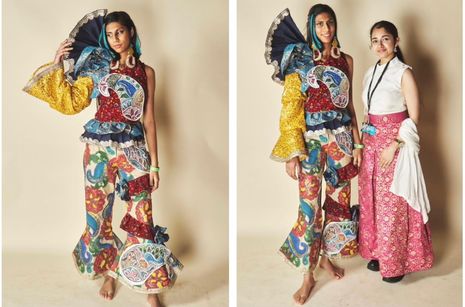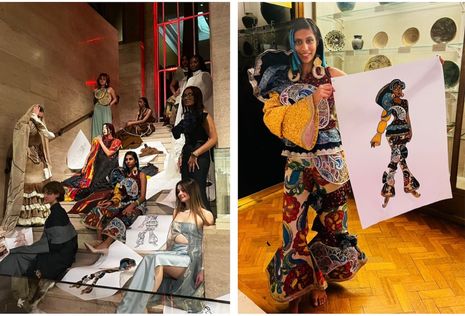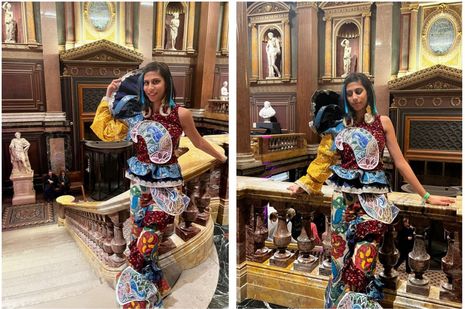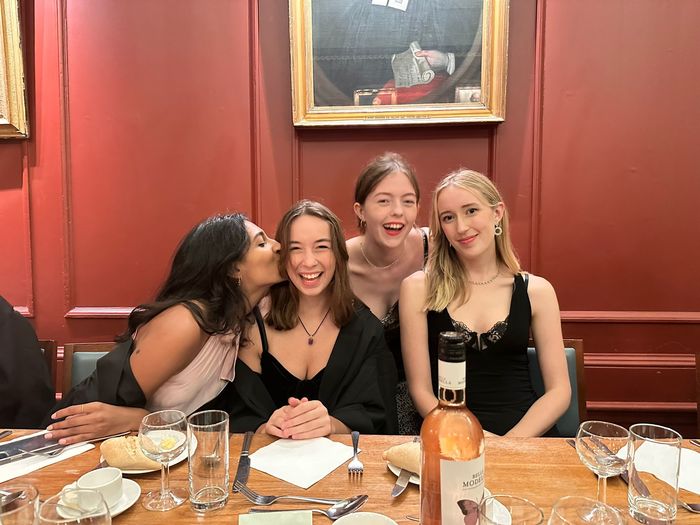Meet the student designers reclaiming cultural identities through fashion
Ria Patel explores how colonial histories can be reclaimed through fashion design

At the Cambridge School of Art, fashion students are not merely creating outfits, but seeking to redesign the fashion industry itself while exploring untold narratives. Inspired by the Fitzwilliam Museum’s exhibition ‘The Black Atlantic: Power, People, Resistance’, their works took centre stage at the museum's ‘Late’ exhibition on 30th November 2023.
I had the amazing privilege of modelling Harleen Kaur’s outfit, named ‘Fragments to Fashion’, which was not only visually appealing but rich in culture and meaning.
“Paisley is not just a pattern, but a symbol of different cultures converging through colonial trade, forming completely new identities”
Harleen delved into the emergence of new cultures forged in resistance to slavery and colonial trade. Beyond their “tragic past”, she emphasises how these elements can “take on a new meaning, a new identity”. Her inspiration was taken from the compelling story of ‘The Black Prince of Perthshire’, the Punjabi Sikh Maharaja Sir Daleep Singh, who was taken at a young age to Britain. The Black Prince’s anglicisation and deprivation of his culture and country led to a distorted sense of identity.

In terms of Harleen’s design, the paisley pattern has a historic significance, with its roots in the ancient Persian Empire and then Kashmir in the 11th century. For her, Paisley is not just a pattern, but a symbol of different cultures converging through colonial trade, forming completely new identities. She mourns the loss of its origin, but emphasises how it also “finds its own unique beauty”. Her creation speaks volumes about how identity can become distorted due to colonialism, blending Indian design elements of Paisley and rich textiles with Western styles of tailoring and cutting. At the heart of her design is this concept of fragmented and distorted identity, being a blend of two different cultures that influenced each other. The asymmetry of the outfit and the combination of different fabrics reinforce this “distorted identity formed by the effects of colonialism.”
In an age of cultural appropriation, Harleen, with her own Indian Punjabi background, aims to “reclaim elements from [her] cultural background” and showcase one of the many unheard stories from colonial Punjab. Equally important to her though is the acknowledgement of “the history that led to the evolution of this merge of art and culture”. Her sustainable and ethical outfit, crafted entirely from scrap material from her family’s fashion business in New Delhi, is a testament to her commitment to these values and originality.
“Each garment becomes a tapestry of shared history”
Another student, Umeima Hatim, responded to the ‘Black Atlantic’ exhibition by transporting us to the Mughal Empire (1526-1857). Her concept was based on the Mughal aesthetic, focusing on narratives around South Asian identity. Her three-piece ensemble – a half-torso cape, a corset, and trousers that were structurally reminiscent of ‘minars’ (towers) celebrates the empire’s renowned architecture, religious tolerance and elevated living standards.

Her celebration of the “harmonious fusion of Hindu, Persian and Islamic elements” is especially relevant for her in the wake of “present-day tragedies unfolding in Palestine”. She feels a “poignant ache” when reflecting on the solace she found in the Mughal era’s cultural and religious harmony, “a stark reminder that history’s colonial shadows persist in our contemporary world”. Umeima appreciates how her Pakistani-Muslim roots and the Mughal Empire’s rich history give her a shared heritage with her ancestors, that “each garment becomes a tapestry of shared history”. She used scrap fabrics that she sourced from friends’ mothers, connecting this sentiment to the symbolisation of “a tangible connection to the intertwined stories of those who contributed to its [the Mughal Empire’s] creation.”
“These students are not just designing clothes; they’re crafting stories, reclaiming identities, and challenging social norms”
Another designer, Andrea Kapetaniou, took us back to her origins in Cyprus, transporting us to the birthplace of the Greek goddess Aphrodite. In reimagining Ancient Greek women’s clothing, Andrea challenges the dichotomy between modesty in Ancient Greek women’s ‘Peplos dress’ and the naked presentation of Aphrodite. She does this by “beautifully defining the curves of the female body’” with silk for the fabrics and organza for the sleeves. Andrea says how she “love[s] how beautifully it shines when there is movement, and it reminds [her] of the ocean when the sun hits the water.”
Edwardina Pepple sought to explore Britain’s role in the enslavement and commodification of Black bodies, while Emma Basso-M’Timkulu drew inspiration from her family’s contribution to ending South African Apartheid, “a prideful depiction of rebellion, versus the oppression of Black South Africans, which has left an everlasting scar on the fabric of this community.” She found intrigue in the notion of carnival as a celebration grounded in challenging social structures, infusing explosive colours and fabrications into her outfit to emphasise this message.
These students are not just designing clothes; they’re crafting stories, reclaiming identities, and challenging social norms. Their creativity and innovation must be applauded, as well as their commitment to redesigning the fashion industry and rallying for cultural revolution.
 News / Uni redundancy consultation ‘falls short of legal duties’, unions say6 December 2025
News / Uni redundancy consultation ‘falls short of legal duties’, unions say6 December 2025 News / Cambridge students accused of ‘gleeful’ racist hate crime4 December 2025
News / Cambridge students accused of ‘gleeful’ racist hate crime4 December 2025 News / Researchers find five stages of brain development5 December 2025
News / Researchers find five stages of brain development5 December 2025 Music / The trials and tribulations of indie collabs 6 December 2025
Music / The trials and tribulations of indie collabs 6 December 2025 News / Cambridge cosies up to Reform UK30 November 2025
News / Cambridge cosies up to Reform UK30 November 2025









